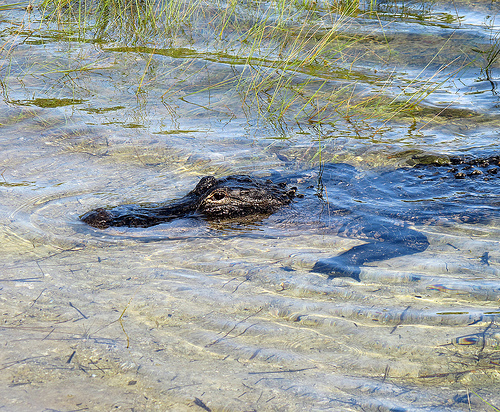
Artist In Residence in the Everglades (AIRIE) diary selection #3
This post is associated with artist and writer Christopher Reiger‘s 2-week-long Artists In Residence In the Everglades (AIRIE) writing and art residency in Everglades National Park.
Notes from Day 10: – I danced a slow-motion tango with the American alligator pictured above. The animal was only about 6 feet long (which I presume is too small to view a full-grown human as a potential meal), but this gator’s eyes may have been bigger than its stomach, so to speak.
When I initially approached the lake, the alligator was about 15 yards from the shore. I squatted at the water’s edge to take some photos of periphyton, spongy masses of algae and microorganisms that play a critical role in the Everglades food web. Although I focused on the periphyton, I occasionally glanced at the alligator; in so doing, I realized that it was slowly, almost imperceptibly nearing my position. When it was about 10 yards away, it submerged. From where I crouched, I could see the dark shape of its body moving more rapidly toward me. I hopped up and retreated to a safe distance. The reptile moved within 8 feet of the shoreline and surfaced, its third eyelids retracting. It stared at me; I stared back. “Are you serious?,” I asked, as though it understood. “Are you eyeing me, buddy?”
After a few minutes, the alligator submerged and moved away, to a spot near its original position. I approached the water, checking carefully to make sure I wasn’t overlooking any other gators in the area, and again squatted. Moments after I did so, my cold-blooded friend sunk beneath the water’s surface and moved toward me, as before.
This dance was repeated several times: the gator approaching, me retreating, the animal moving away, me approaching and crouching, repeat. I have to conclude that, when hunkered down, I appeared to be of a size that a hungry, 6-foot gator could take. The animal was moving into a position from which it could strike. While I doubt that it could kill me easily, I’ve no doubt that it could do me serious harm.
I decided to leave the area. As the old adage has it, no photo of periphyton is worth loosing a hand.
Notes from Day 12: -While I watched, a male anhinga caught a bluegill in the flooded borrow pit by Anhinga Trail. The fish was at least 3 inches in length, and the anhinga decided that he’d better not attempt to eat the fish while still in the water. Unlike most fish-eating birds, anhingas have to throw the fish they catch up into the air, open their beak wide, and swallow the fish as it descends. It’s quite a trick to see, especially when the fish, as in the case of this bluegill, is of a fair size. The anhinga waddled (like penguins, anhingas are evolved for diving and swimming, and they’re graceless on land) up the grass slope at the borrow pit’s edge, his catch held tight in his bill. He moved onto the paved trail and, surrounded by a small group of excited German tourists (and me), pulled off the fish tossing feat with aplomb.
– During the early days of my stay in the park, I didn’t hear any cicadas. Now that the rain has become infrequent, however, I hear their clicking whine all day long. It reminds me of the Eastern Shore of Virginia, my home ground.
– I stopped for 2 more common snapping turtles crossing park roads. One of these was an especially fine model. I also rescued a Florida box turtle from harassment by two American crows. Whether the crows would have eventually gotten past the turtle’s shell defense, I don’t know, but corvids are clever birds and, though I’m very fond of them, I opted to spoil their fun and potential meal by moving the turtle off the road and into the undergrowth at the forest’s edge. The crows clucked and rattled at me in disapproval.
The above post is an abridged version of artist and writer Christopher Reiger‘s AIRIE diary, originally published on his art and natural history blog, Hungry Hyaena, in October 2011.
Recent Content
-
Artsarticle ·
-
Artsarticle ·
-
Artsarticle ·




